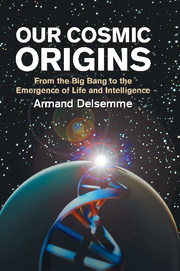Book contents
- Frontmatter
- Contents
- Foreword
- Preface
- Acknowledgments
- 1 Locating humans in the Universe
- 2 The race toward complexity
- 3 The stellar alchemy of metals
- 4 The formation of the planets
- 5 The emergence of life
- 6 The history of life
- 7 The awakening of intelligence
- 8 The other worlds
- 9 Perspectives
- APPENDIX A The standard model of the physics of elementary particles
- APPENDIX B Symmetry in physics
- APPENDIX C The strange role of time in relativity
- APPENDIX D The measurement of long time spans and the age of the Universe
- APPENDIX E The standard model of the Big Bang
- APPENDIX F The cause of the Big Bang and inflation
- APPENDIX G Chirality
- Glossary
- Bibliography
- Figure index
- Table index
- Name index
- Subject index
1 - Locating humans in the Universe
Published online by Cambridge University Press: 05 August 2012
- Frontmatter
- Contents
- Foreword
- Preface
- Acknowledgments
- 1 Locating humans in the Universe
- 2 The race toward complexity
- 3 The stellar alchemy of metals
- 4 The formation of the planets
- 5 The emergence of life
- 6 The history of life
- 7 The awakening of intelligence
- 8 The other worlds
- 9 Perspectives
- APPENDIX A The standard model of the physics of elementary particles
- APPENDIX B Symmetry in physics
- APPENDIX C The strange role of time in relativity
- APPENDIX D The measurement of long time spans and the age of the Universe
- APPENDIX E The standard model of the Big Bang
- APPENDIX F The cause of the Big Bang and inflation
- APPENDIX G Chirality
- Glossary
- Bibliography
- Figure index
- Table index
- Name index
- Subject index
Summary
‘For what is Man in nature? A nothingness in respect to infinity, a whole in respect to nothingness, a median between nothing and everything’
Blaise Pascal, Les Pensées, 1670Introduction
Even more than the Renaissance period, the twentieth century will be remembered in human memory as an extraordinary era in every regard. The awareness of our true position, and of our isolation, in an immense and mysterious Universe began nearly 400 years ago, but recently it has expanded enormously (see Figure 1.1 A and B).
At the end of the nineteenth century, we did not know where we were, or where we came from; we did not even realize that we did not know it. The vastness of space and time had always been thought to be beyond any possible observation or experiment; in a word, their study was considered to be a part of metaphysics. Metaphysics concerns everything that might exist, but which we have no means of detecting. In contrast, the physical world is made up of what we can see, touch, hear, taste and smell, i.e. observe. In this sense it can be said that angels are a part of metaphysics, whereas a chair is part of the physical world.
Over the last 300 years, we have invented new means of detection that have extended our senses and give them ‘feelers’. We have rolled back the limits of metaphysics more and more.
- Type
- Chapter
- Information
- Our Cosmic OriginsFrom the Big Bang to the Emergence of Life and Intelligence, pp. 1 - 18Publisher: Cambridge University PressPrint publication year: 1998

